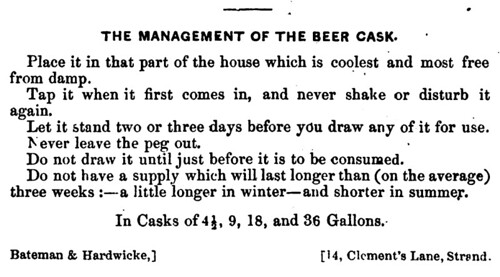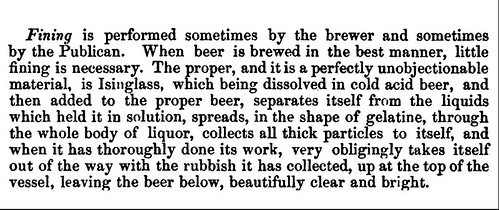In 1765, the Swan Brewery began brewing in London. It would continue doing so for an additional one hundred seventy-one years until 1936, when the Ind Coope/Samuel Allsopp & Sons brewing consortium purchased the brewery ... and promptly closed it.
But nearly a century earlier, in 1850, when The Swan was still going strong, it published a pamphlet for the trade that described its brewing procedures and its beers, and offered advice on how to properly care for them. Included was a short passage on cask cellarmanship. It was sensible advice then and remains so now, nearly two centuries later.

The Management Of The Beer Cask—"The Proprietors of the Swan Brewery, Walham Green, Fulham - (Established 1765) - Beg to Present These Pages on Beer and Brewing; and Will Feel Honoured by Their Acceptence and Perusal."
- Place it in that part of the house which is coolest and most free from damp.
- Tap it when it first comes in, and NEVER SHAKE OR DISTRUB IT AGAIN [emphasis mine].
- Let it stand two or three days before you draw any of it for use.
- Never leave the peg out.
- Do not draw it until just before it is to be consumed.
- Do not have a supply which will last longer than (on the average) three weeks: —a little longer in winter— and shorter in summer.
1850
Note the cask sizes mentioned: 4.5, 9 (firkin), 18, and 36 gallons. Swan, of course, listed them in Imperial (U.K.) measure. Translating to U.S. volumes, they would be, respectively: 5.4, 10.8 (firkin), 36, and 72 gallons.
The short pamphlet also discussed the clarification of cask ale, i.e, the fining of casks.
Fining is performed sometimes by the brewers and sometimes by the Publican. When beer is brewed in the best manner, little fining is necessary. The proper, and it is perfectly unobjectionable material is Isinglass, which being dissolved in cold acid beer, and then added to the proper beer, separates itself from the liquids which held it in solution, spreads, in the shape of gelatine, through the whole body of liquor, collects all thick particles to itself, and when it has thoroughly done its work, very obligingly takes itself out of the way with the rubbish it has collected, up at the top of the vessel, leaving the beer below, beautifully clear and bright.
Ah, but what is the "perfectly unobjectionable material," isinglass? Here, from the The Oxford Companion to Beer (2012):
Isinglass is derived from the swim bladders of certain tropical and subtropical fish. [...] Traditionally, isinglass for brewing purposes was derived from sturgeon, although modern commercial isinglass is more typically derived from tropical estuarine dwellers. [...] When used as a fining agent, [isinglass] has the ability to settle yeast and beer proteins very quickly and can do so repeatedly. This latter property is essential for cask-conditioned ales, where the casks may be moved several times prior to serving.
Many cellarmen in 21st-century U.S. have switched from the use of isinglass to non-animal-derived agents for clarifying cask ales. Others rely on gravity and time and/or rapidly-settling yeast strains.
But many others, sad to say, when it comes to cask quality, isinglass or no isinglass, couldn't
-----more-----
- This post originally appeared (albeit in shorter fashion) at YFGF's Facebook page.
- A tip of the YFGF fedora to Gary Gillman. His post —"An English Brewery’s Product Guide, 1850" — deals with the bulk of the Swan pamphlet: a fascinating look at British beer styles of the mid-19th-century...at least at that one brewery. Worth a read.
- See a reproduction of the entire Swan 1850 pamphlet, at Google Books (The cask bit is on p.18.)
- "Fining" is pronounced FINE (rhymes with wine)-ing and "finings" the same, but with a final 's.'
- One non-animal-derived clarification agent is colloidal silicic acid. It is sold commercially as BioFine.
- For more from YFGF:
- Follow on Twitter: @Cizauskas.
- Like on Facebook: YoursForGoodFermentables.
- Follow on Flickr: Cizauskas.
- Follow on Instagram: @tcizauskas.











No comments:
Post a Comment
Comment here ...